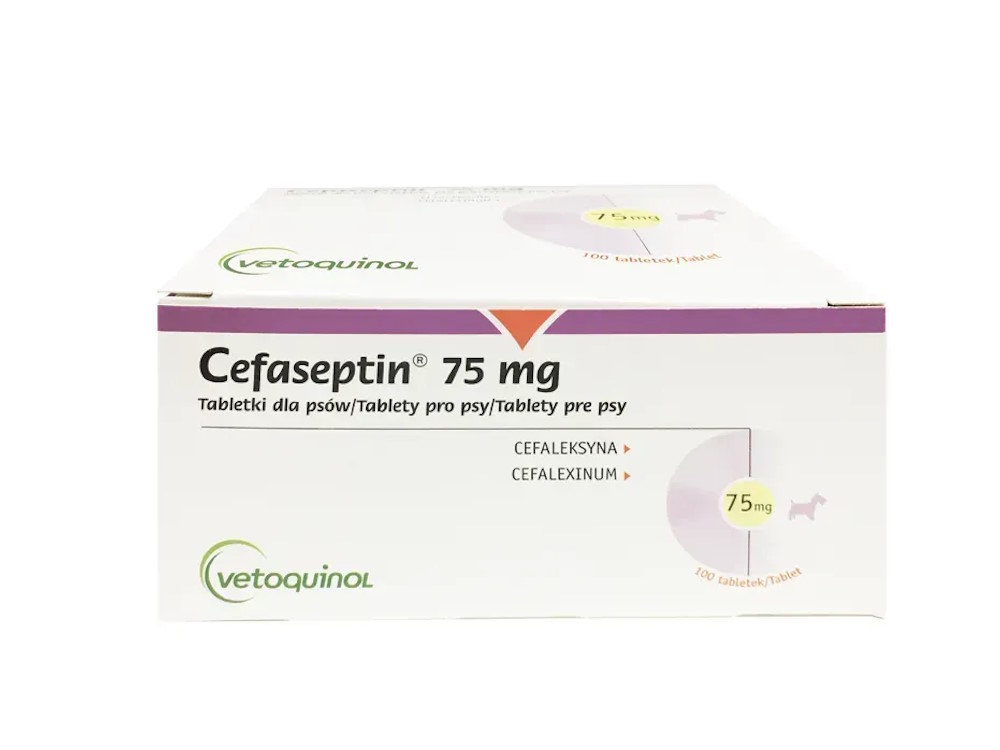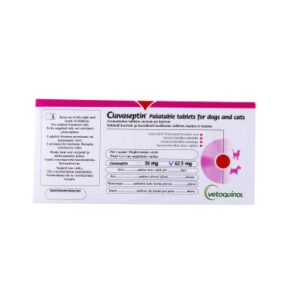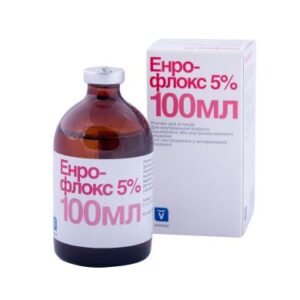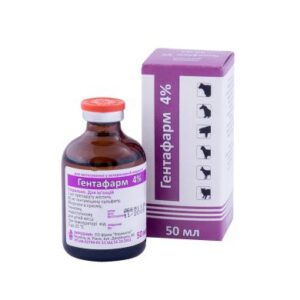

Cefasep 75 for dogs and cats 10 tablets
30.99 € Original price was: 30.99 €.24.79 €Current price is: 24.79 €.
| Animals | , |
|---|---|
| Brands | |
| Form |
Cefaseptin (cephalexin) 75 mg, 10 tabs
Description
Oblong beige tablets with a dividing groove into 2 parts.
Composition
1 tablet (75 mg) of the drug contains the following active ingredients:
- cephalexin (as cephalexin monohydrate) — 75.0 mg,
Excipients: lactose monohydrate, crospovidone, povidone K30, croscarmellose sodium, microcrystalline cellulose, liver flavor, yeast flavor, sodium stearyl fumarate.
Pharmacological properties
ATC vet classification code — QJ01DB01. Antibacterials for systemic use, first-generation cephalosporins.
Cephalexin is a bactericidal antibiotic with a time-varying activity that acts by inhibiting the synthesis of bacterial cell wall nucleopeptides. Cephalosporins inhibit transpeptidation enzymes, preventing the cross-linking of peptidoglycans in the bacterial cell wall. Cross-linking of glycans is necessary for the cell to build the cell wall. Inhibition of biosynthesis leads to a weakening of the cell wall, which eventually ruptures under osmotic pressure. The combined effect leads to cell lysis and filament formation.
Cephalexin is active against a broad spectrum of gram-positive (e.g., Staphylococcus spp.) and gram-negative (e.g., Escherichia coli) aerobic bacteria.
The Clinical and Laboratory Standards Institute (VET08, 4th edition, August 2019) recommends the following cut-off values for dogs:
For dogs with skin and soft tissue infections:
| Types of bacteria | Inclined | Resistant |
| Staphylococcus aureus Staphylococcus pseudintermedius |
≤ 2 | ≥ 4 |
| Streptococcus spp
E. coli |
≤ 2 | ≥ 8 |
For dogs with urinary tract infections:
| Types of bacteria | Inclined | Resistant |
| E. coli Klebsiella pneumoniae Proteus mirabilis |
≤ 16 | ≥ 32 |
MIC data for the use of cefaceptin in dogs with skin and soft tissue infections and urinary tract infections
Data was collected from 2011 to 2017.
| Types of bacteria | MIC range (mg/L) |
MIC 50 (mg/l) |
MIC 90 (mg/l) |
| Dermatological infections | |||
| Staphylococcus spp.a | 0,25-512 | 0,993 | 12,435 |
| Staphylococcus aureusb | 1-512 | 2,160 | 153,987 |
| Coagulase negative staphylococcusc | 0,25-64 | 0,989 | 14,123 |
| Staphylococcus pseudintermediusb | 0,5-512 | 0,768 | 5,959 |
| Streptococcus spp.d | 0,06-0,5 | 0,155 | 0,234 |
| Streptococcus canisd | 0,06-0,5 | 0,146 | 0,226 |
| Streptococcus dysgalactiaed | 0,25-0,5 | 0,185 | 0,354 |
| Escherichia colib | 4-512 | 5,481 | 11,314 |
| Pasteurella multocidab | 0,12-4 | 1,373 | 1,877 |
| Urinary tract infections | |||
| Proteus mirabilisb | 8-512 | 6,498 – 12,491 | 12,553 – 207,937 |
| Klebsiella pneumoniaeb | 2-512 | 3,564 | 362,039 |
| E. coli b | 4-512 | 5,022-5,82 | 7,671-13,929 |
a: period 2011-2017; b: period 2011-2015; c: period 2016-2017; d: period 2012-2015
MIC data for the use of cefaceptin for cats with skin and soft tissue infections
In the absence of breakpoints for cephalexin against bacterial species isolated from feline skin infections, the highest MIC values in the non-mutant type MIC distribution (ECOFF) are shown. Data were collected from 2011 to 2017.
| Types of bacteria | MIC range (mg/L) |
MIC 50 (mg/l) |
MIC 90 (mg/l) |
ECOFF e (μg/ml) |
| Dermatological infections | ||||
| Staphylococcus spp.a | 0,25-512 | 0,993 | 12,435 | < 8 |
| Staphylococcus aureusb | 1-512 | 2,160 | 153,987 | < 8 |
| Coagulase negative staphylococcusc | 0,25-64 | 0,989 | 14,123 | < 2 |
| Staphylococcus pseudintermediusb | 0,5-512 | 0,768 | 5,959 | < 2 |
| Streptococcus spp.d | 0,06-0,5 | 0,155 | 0,234 | < 0,5 |
| Streptococcus canisd | 0,06-0,5 | 0,146 | 0,226 | < 0,5 |
| Streptococcus dysgalactiaed | 0,25-0,5 | 0,185 | 0,354 | < 0,5 |
| Escherichia colib | 4-512 | 5,481 | 11,314 | < 16 |
| Pasteurella multocidab | 0,12-4 | 1,373 | 1,877 | < 4 |
Cephalexin resistance may be due to one of these resistance mechanisms. First, the production of cephalosporinase, which inactivates the antibiotic by hydrolysis of the β-lactam ring, is the most common mechanism among Gram-negative bacteria. This resistance is plasmid- or chromosomally transmitted. Second, reduced affinity of PBPs (penicillin-binding proteins) for β-lactam drugs is often associated with β-lactam resistance in Gram-positive bacteria. Finally, efflux pumps that excrete the antibiotic from the bacterial cell and structural changes in porins that reduce passive diffusion of the drug across the cell membrane may contribute to the bacterial resistant phenotype.
Well-known cross-resistance (with the same mechanism of resistance) exists between antibiotics belonging to the beta-lactam group due to structural similarities. This occurs through beta-lactamase enzymes, structural changes in porins, or variations in efflux pumps. Co-resistance (different mechanisms of resistance involved) has been described in E. coli through a plasmid containing different resistance genes.
Pseudomonas aeruginosa is known for its resistance to cephalexin.
Application
Cats:
- For the treatment of skin and subcutaneous infections (wounds and abscesses) caused by Streptococcus spp., Escherichia coli, Pasteurella spp., sensitive to cephalexin.
Dogs:
- For the treatment of bacterial skin infections (including deep and superficial pyoderma) caused by microorganisms, including those sensitive to cephalexin.
- For the treatment of urinary tract infections (including nephritis and cystitis) caused by microorganisms, including Escherichia coli, susceptible to cephalexin.
Dosage
Oral use.
15 mg cephalexin per kg body weight twice daily (equivalent to 30 mg per kg body weight per day), corresponding to one tablet per 5 kg body weight twice daily for:
Dogs:
- Urinary tract infection: 14 days.
- Superficial bacterial skin infection: at least 15 days.
- Deep bacterial skin infection: at least 28 days.
Cats:
- Skin and subcutaneous infections (wounds and abscesses): 5 days.
To ensure correct dosing, body weight should be determined as accurately as possible to avoid underdosing.
If necessary, the drug can be crushed or added to food.
In severe or acute conditions, except in cases of known renal insufficiency, the dose may be doubled.
*Kilograms to Pounds conversion table
| Kilograms (kg) | Pounds (lb) | Pounds+Ounces (lb+oz) |
| 0.1 kg | 0.220 lb | 0 lb 3.527 oz |
| 1 kg | 2.205 lb | 2 lb 3.274 oz |
| 5 kg | 11.023 lb | 11 lb 0.370 oz |
| 10 kg | 22.046 lb | 22 lb 0.740 oz |
Contraindication
Do not use in case of known hypersensitivity to the active substance, to other cephalosporins, to other β-lactams or to any of the excipients. Do not use in cases of known resistance to cephalosporins or penicillins.
Do not use on rabbits, guinea pigs, hamsters and gerbils.
Reservation
Side effect
In clinical studies, mild and transient vomiting and/or diarrhea were commonly observed in cats.
Most of these adverse reactions were observed once. They were reversible without symptomatic treatment and without discontinuation of cephalexin treatment.
In rare cases, hypersensitivity may occur.
If hypersensitivity reactions develop, treatment should be discontinued.
In very rare cases, some dogs have experienced nausea, vomiting and/or diarrhea after administration.
Release form
Laminated aluminum blisters of 10 tablets, in cardboard boxes of 10, 100 and 250 tablets.
Storage
Dry, dark place, inaccessible to children, at a temperature of 10 ºС to 25 ºС.
Expiration date
3 years.
The unused half tablet should be used within 16 hours.
For use in veterinary medicine!
























